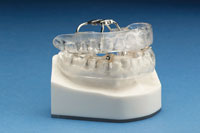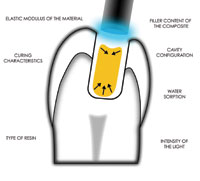Although the average American will chew about 300 sticks of gum a year, in the past a chewing gum habit has been criticized by some clinicians as harmful. For example, in 1869 a physician wrote that chewing gum would “exhaust the salivary glands and cause the intestines to stick together.”1 Today, we recognize that chewing gum does not cause those maladies, nor does it lead to clicking and popping of the TMJ.
|
Table. Components of Saliva and Their Function. 2,4
|
In humans, saliva is generated by 3 pairs of major and numerous minor salivary glands. The minor glands are located within the oral mucosa, including lips, buccal mucosa, and soft palate. The major salivary glands produce 93% of all saliva.4 The salivary glands are under the control of the autonomic nervous system and respond to hormonal influences. Saliva is formed in the acinar cells of the glands via an osmotic mechanism. Saliva is 99% water. The remaining components are macromolecules, which are formed within the endoplasmic reticulum of the acinar cells2,3 and secreted by the ducts into the lumen (Table).
Daily saliva output is in the range of 500 to 1,500 mL, although the average resting volume of saliva in the oral cavity at any one time is only 1 mL.2,3 Saliva output may either be resting (basal) or stimulated, and stimulation increases the flow rate. Mean resting saliva output (whole saliva) is 0.4 mL/minute and is highest in the morning.2 Stimulated saliva output, which is driven by masticatory or gustatory signals, is between 1 to 2 mL/minute. When the saliva is stimulated, there is an increase in the concentration of bicarbonate ions, which consequently causes a rise in the pH, increasing the buffering capacity of saliva against the acids formed after carbohydrate ingestion.2-5
Adequate saliva is critical for good oral health. Aside from lubricating the tissues, saliva helps maintain a pH environment that promotes tooth remineralization via deposition of ionic minerals available in solution and serves an antimicrobial function as a result of the immunoglobulins and proteins present in the fluid. Saliva assists in digesting, diluting, and clearing dietary carbohydrates as well as buffering of acid that is a byproduct of the metabolism of sugar. Due to the presence of histatins (proline-rich proteins including cystatins and statherin), calcium and phosphate are maintained in supersaturation and are available for remineralization of tooth structure.3 In addition, saliva aids in maintaining mucosal integrity and aids in digestion as a result of enzymes in the fluid. Saliva also is integral to the formation of the pellicle, which protects the tooth after eruption (Table).
Saliva’s buffering capacity maintains the health of the dentition. For the 2 hours after carbohydrate ingestion and acid production by oral bacteria, there is a drop in pH. Following ingestion of a dietary sugar, the stimulated production of saliva ceases after the sugar clears the mouth, and salivary output returns to a resting state within a short time.5,6 The tooth is most susceptible to demineralization and white spot production during the period of lowered pH. The need for protection afforded by salivary buffers is highest after carbohydrate consumption.
Saliva must be present in the oral cavity to preserve the integrity of both oral hard and soft tissues. Therefore, methods should be examined to increase salivary flow. Cholinergic agonists, such as pilocarpine (Salagen) and cevimeline (Evoxac), may be prescribed to stimulate salivary flow in postradiation patients and those with Sjogrens syndrome.3 Maintaining the salivary flow during normal waking hours is imperative. As there is a rapid decrease in pH after ingestion of sugar with a concomitant return to the basal flow rate of saliva when the stimulating signals have ceased, approaches to decrease or balance the detrimental effect of this decrease in pH should be considered. Stimulation of saliva by non-food products such as sugarless chewing gum can increase the salivary flow rate with no detrimental effects on the oral tissues.
Masticatory stimulation such as gum chewing causes the salivary glands to produce more fluid. This stimulated saliva contains more ions, including neutralizing bicarbonate, calcium, and phosphorous, which are available to remineralize dental enamel. When a sweetness or flavor is added to chewing gum, there is a 10-fold increase in flow rate compared to stimulation by mastication alone. Even after 20 minutes of chewing, saliva output is elevated 3-fold.10
Several studies have concluded that chewing sugarless gum containing polyols such as sorbitol or xylitol will increase salivary flow.8,10-20 The production of stimulated saliva increases the presence of bicarbonate ions and thereby increases the buffering capacity of saliva, raising the pH after carbohydrate consumption. The 20-minute to 30-minute acidogenic challenge after carbohydrate ingestion can be counteracted by the increased volume of saliva, the increase in bicarbonate ion concentration, and the concomitant rise in pH. The increased availability of bicarbonate ions will decrease the harmful effects of organic acids on the hydroxyapatite crystals of enamel. The increase in fluid volume assists in oral clearance, thereby removing more of the challenge created by the ingestion of acidogenic food or drink.
Chewing gum for 20 minutes after consuming carbohydrates promotes remineralization by raising the pH and the amount of available calcium and phosphate ions in the saliva.6,8-18 The lower pH generated after carbohydrate consumption causes the hydroxyapatite crystals to dissolve, resulting in tooth demineralization. The demineralization/remineralization cycle needs to be in equilibrium; loss of mineral without replacement will lead to tooth damage. Stimulated salivary flow will enable more ions to be available in solution for remineralization.
Volatile sulfur-containing compounds are released from anaerobic bacteria associated with periodontal disease as well as metabolism of host cells and are the cause of halitosis.21 Cinnamic aldehyde from plant essential oils has been shown to kill these bacteria on a short-term basis; hence cinnamon flavor might be useful in eliminating halitosis.21 Nicotine-containing gums are currently available as part of smoking cessation programs. All these products will increase salivary stimulation while delivering specific active substances into the oral cavity, which then are available systemically.
CONCLUSIONS
Stimulation of saliva increases the level of bicarbonate ions in the oral cavity, which raises the pH to neutralize acids produced as a byproduct of the metabolism of fermentable carbohydrates. The concentration of calcium and phosphate ions available in supersaturated salivary fluid is increased, promoting tooth remineralization. Mastication allows for clearance of fermentable carbohydrates from the oral cavity. Chewing sugarless gum can provide all 3 of these oral health benefits. Under certain conditions, recommending chewing of sugarless gum after acidogenic exposures can promote oral health, producing an environment that favors tooth remineralization and facilitates clearance of fermentable carbohydrates.
References
1. Fascinating facts about the invention of chewing gum by Thomas Adams in 1845. The Great Idea Finder Web site. Available at: http://www.ideafinder.com/history/inventions/story056.htm. Accessed May 22, 2004.
2. A Symposium on the Endogenous Benefits of Saliva in Oral Health. March 21, 1989. LSU School of Dentistry, New Orleans, LA. Compend Suppl. 1989;(13):S448-S488.
3. Diaz-Arnold AM, Marek CA. The impact of saliva on patient care: a literature review. J Prosthet Dent. 2002;88:337-343.
4. Dowd FJ. Saliva and dental caries. Dent Clin North Am. 1999;43:579-597.
5. Edgar WM. A role for sugar free gum in oral health. J Clin Dent. 1999;10:89-93.
6. Lenander-Lumikari M, Loimaranta V. Saliva and dental caries. Adv Dent Res. Dec 2000;14:40-47.
7. Edgar WM. Saliva and dental health. Clinical implications of saliva: report of a consensus meeting. Br Dent J. Aug 11-25 1990;169:96-98.
8. Edgar WM. The clinical implications of salivary stimulation. Gen Dent Practitioner. Jul/Aug 1989:9-12.
9. Navazesh M, Denny P, Sobel S. Saliva: a fountain of opportunity. J Calif Dent Assoc. 2002;30:783-788.
10. Itthagarun A, Wei SH. Chewing gum and saliva in oral health. J Clin Dent. 1997;8(6):159-162.
11. Imfeld T. Chewing gum—facts and fiction: a review of gum-chewing and oral health. Crit Rev Oral Biol Med. 1999;10:405-419.
12. Simons D. Chewing gum: trick or treat? A review of the literature. Dent Update. 1996;23:162-169.
13. Koparal E, Ertugrul F, Sabah E. Effect of chewing gum on plaque acidogenicity. J Clin Pediatr Dent. 2000;24:129-132.
14. Creanor SL, Strang R, Gilmour WH, et al. The effect of chewing gum use on in situ enamel lesion remineralization. J Dent Res. 1992;71:1895-1900.
15. Leach SA, Lee GT, Edgar WM. Remineralization of artificial caries-like lesions in human enamel in situ by chewing sorbitol gum. J Dent Res. 1989;68:1064-1068.
16. Jensen ME. Effects of chewing sorbitol gum on human salivary and interproximal plaque pH. J Clin Dent. 1988;1:6-19.
17. Szoke J, Banoczy J, Proskin HM. Effect of after-meal sucrose-free gum-chewing on clinical caries. J Dent Res. 2001;80:1725-1729.
18. Dawes C, Macpherson LM. Effects of nine different chewing-gums and lozenges on salivary flow rate and pH. Caries Res. 1992;26:176-182.
19. Polland KE, Higgins F, Orchardson R. Salivary flow rate and pH during prolonged gum chewing in humans. J Oral Rehabil. 2003;30:861-865.
20. Hanham A, Addy M. The effect of chewing sugar-free gum on plaque regrowth at smooth and occlusal surfaces. J Clin Periodontol. 2001;28:255-257.
21. Zhu M, Carvalho RHR, Scher A, et al. Short-term germ-kill effect of chewing gum containing plant essential oils. Paper presented at: IADR/AADR 82nd General Session; March 10-13, 2004; Honolulu, Hawaii. Available at: http://iadr.confex.com/iadr/2004Hawaii/techprogram/abstract_45849.htm. Accessed July 15, 2004.
Dr. Doniger has been in private practice of family and preventive dentistry for almost 20 years. She is currently focusing on women’s health and well-being issues. She can be contacted at (847) 677-1101 or donigerdental@aol.com.










